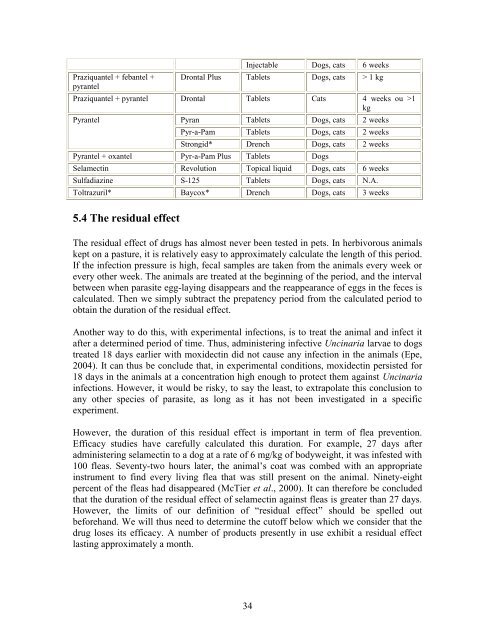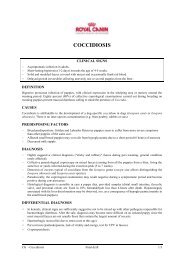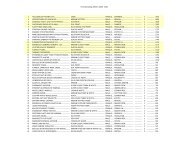Guide to Preventing Parasites.pdf - Royal Canin Canada
Guide to Preventing Parasites.pdf - Royal Canin Canada
Guide to Preventing Parasites.pdf - Royal Canin Canada
You also want an ePaper? Increase the reach of your titles
YUMPU automatically turns print PDFs into web optimized ePapers that Google loves.
Praziquantel + febantel +<br />
pyrantel<br />
Injectable Dogs, cats 6 weeks<br />
Drontal Plus Tablets Dogs, cats > 1 kg<br />
Praziquantel + pyrantel Drontal Tablets Cats 4 weeks ou >1<br />
kg<br />
Pyrantel Pyran Tablets Dogs, cats 2 weeks<br />
Pyr-a-Pam Tablets Dogs, cats 2 weeks<br />
Strongid* Drench Dogs, cats 2 weeks<br />
Pyrantel + oxantel Pyr-a-Pam Plus Tablets Dogs<br />
Selamectin Revolution Topical liquid Dogs, cats 6 weeks<br />
Sulfadiazine S-125 Tablets Dogs, cats N.A.<br />
Toltrazuril* Baycox* Drench Dogs, cats 3 weeks<br />
5.4 The residual effect<br />
The residual effect of drugs has almost never been tested in pets. In herbivorous animals<br />
kept on a pasture, it is relatively easy <strong>to</strong> approximately calculate the length of this period.<br />
If the infection pressure is high, fecal samples are taken from the animals every week or<br />
every other week. The animals are treated at the beginning of the period, and the interval<br />
between when parasite egg-laying disappears and the reappearance of eggs in the feces is<br />
calculated. Then we simply subtract the prepatency period from the calculated period <strong>to</strong><br />
obtain the duration of the residual effect.<br />
Another way <strong>to</strong> do this, with experimental infections, is <strong>to</strong> treat the animal and infect it<br />
after a determined period of time. Thus, administering infective Uncinaria larvae <strong>to</strong> dogs<br />
treated 18 days earlier with moxidectin did not cause any infection in the animals (Epe,<br />
2004). It can thus be conclude that, in experimental conditions, moxidectin persisted for<br />
18 days in the animals at a concentration high enough <strong>to</strong> protect them against Uncinaria<br />
infections. However, it would be risky, <strong>to</strong> say the least, <strong>to</strong> extrapolate this conclusion <strong>to</strong><br />
any other species of parasite, as long as it has not been investigated in a specific<br />
experiment.<br />
However, the duration of this residual effect is important in term of flea prevention.<br />
Efficacy studies have carefully calculated this duration. For example, 27 days after<br />
administering selamectin <strong>to</strong> a dog at a rate of 6 mg/kg of bodyweight, it was infested with<br />
100 fleas. Seventy-two hours later, the animal’s coat was combed with an appropriate<br />
instrument <strong>to</strong> find every living flea that was still present on the animal. Ninety-eight<br />
percent of the fleas had disappeared (McTier et al., 2000). It can therefore be concluded<br />
that the duration of the residual effect of selamectin against fleas is greater than 27 days.<br />
However, the limits of our definition of “residual effect” should be spelled out<br />
beforehand. We will thus need <strong>to</strong> determine the cu<strong>to</strong>ff below which we consider that the<br />
drug loses its efficacy. A number of products presently in use exhibit a residual effect<br />
lasting approximately a month.<br />
34







